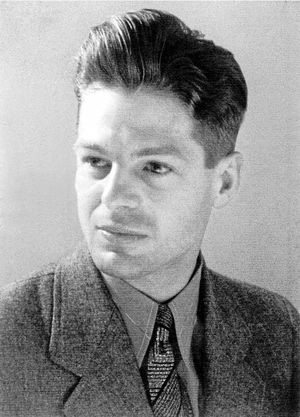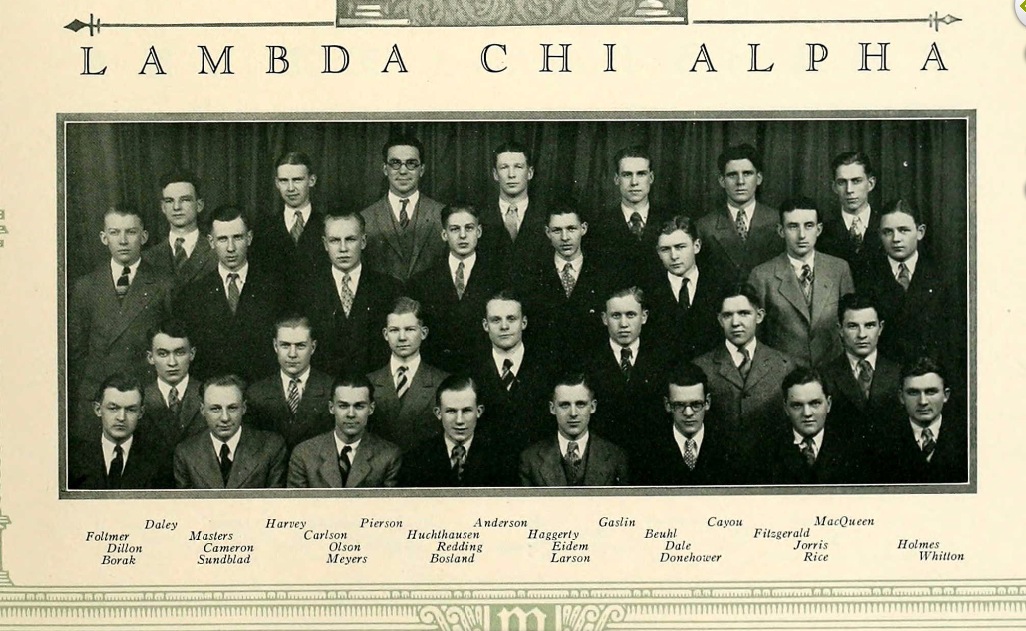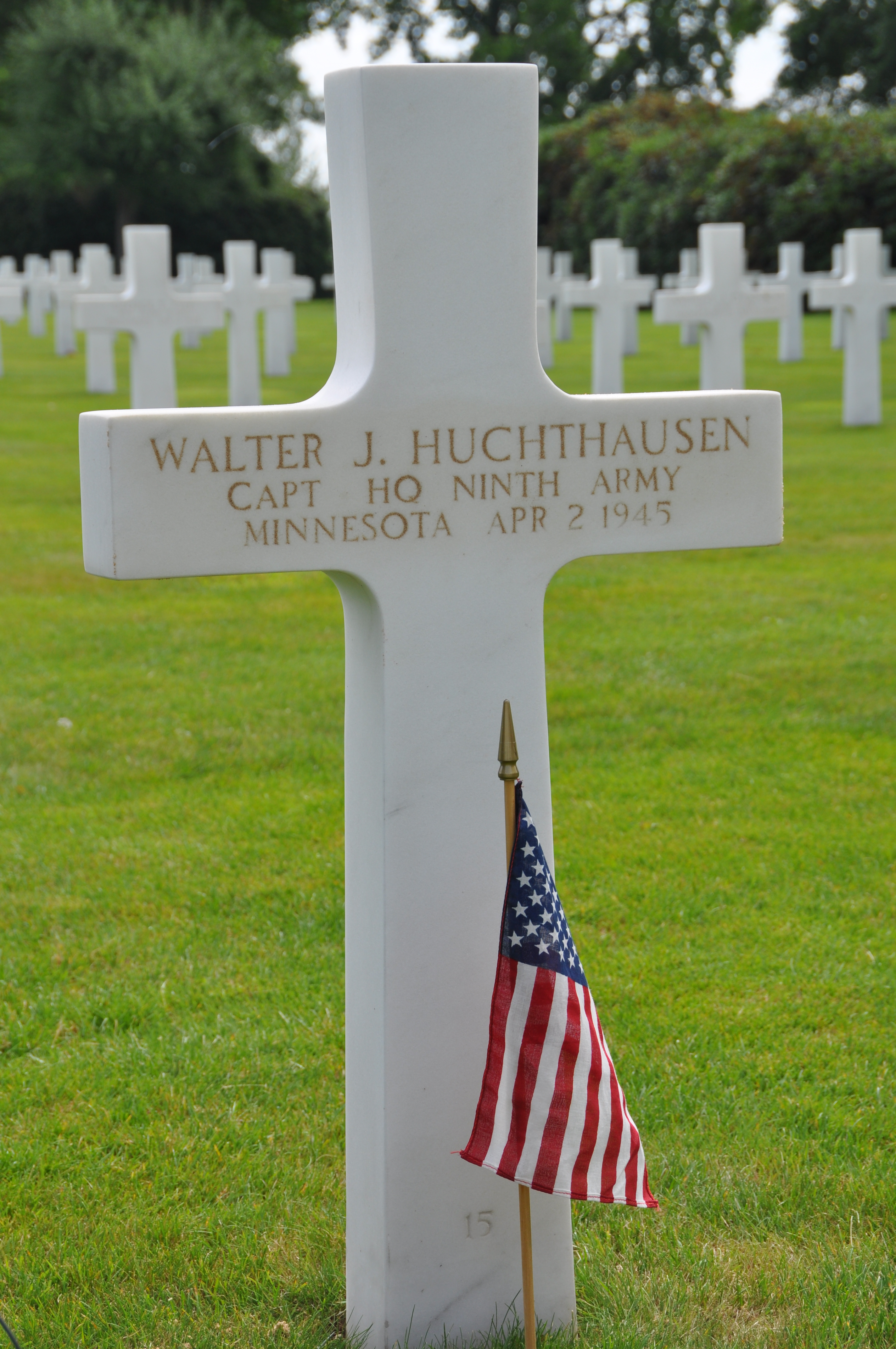Captain Walter J. Huchthausen

- Unit: 9th Army
- Service Number: O-910847
- Date of Birth: December 19, 1904
- Entered the Military: November 30, 1941
- Date of Death: April 2, 1945
- Hometown: Minneapolis-St. Paul, Minnesota
- Place of Death: North of Essen and East of Aachen, Germany
- Award(s): Bronze Star, Purple Heart
- Cemetery: Plot L, Row 1, Grave 15. Netherlands American Cemetery, Margraten, Netherlands
Francis Parker School
2014-2015
Early Life
Before the War
Walter Huchthausen was one of five children born to German immigrant Julius Huchthausen and his wife, Ida. Julius served as a Lutheran minister in various churches in Oklahoma and Washington before settling in Minnesota during the 1920s.
An award-winning architect
Walter attended the University of Minnesota. He joined an academic fraternity and an honorary art fraternity. He also served as the art editor for the university’s magazine, the Minnesota Techno-Log. Huchthausen won several awards for academics and art. One of the most prestigious, the Magney and Husler prize, was from the American Institute of Architects for the student with the highest academic standing over four years. He also created an award-winning design for the university’s architectural drawing competition.
Huchthausen earned a master’s degree in architecture from Harvard University. He then studied in Germany under a Harvard fellowship. His fluency in German would later be instrumental in his service in World War II. In 1939, Huchthausen returned to the University of Minnesota to teach architectural design, drawing, and painting. During the next few years, he designed buildings, including a Gothic revival church, in St. Paul. He also created designs for monuments and painted watercolors.

Huchthausen (second from right, middle row) as a member of Lambda Chi Alpha fraternity at the University of Minnesota, 1928. Courtesy of the University of Minnesota.

This drawing by Walter Huchthausen earned the Magney and Husler prize in 1928. Courtesy of the University of Minnesota.
Military Experience
Walter Huchthausen left the University of Minnesota in 1942, at age 37, and enlisted in the Army Air Forces. He trained at Ellington Field in Texas and was deployed to Great Britain. While in London, a bombing raid by the Luftwaffe, another name for the German air force, injured Huchthausen. After he recovered, the Monuments and Fine Arts and Archives Commission (MFAA) recruited him for frontline work in Germany.
The Allied armies housed the MFAA program in the Civil Affairs and Military Government Section. Created in 1943 in the United States, it eventually grew to include over 300 men and women from 13 countries. In recent years, this group has been called the “Monuments Men” in books, television and movies. Many of them, like Huchthausen, had worked as artists, architects, museum curators, or educators before the war. Their role was to protect cultural treasures endangered by the war.
They also worked to collect artifacts displaced by the war. Some MFAA officers, like Huchthausen, took part in battle preparations, supplying Allied pilots with locations of important monuments, so pilots could target alternate sites. When warfare damaged cultural treasures, MFAA officers moved into the area with frontline troops to assess damage and make repairs.
Recovery efforts in the former seat of Charlemagne’s empire
By the fall of 1944, Huchthausen was staff officer for the MFAA in the 9th Army in France. He moved with the 9th Army as it fought its way into western Germany. The army entered Charlemagne’s 1,100-year-old capital in the city of Aachen in late October. Both sides had suffered heavy losses in the Battle of Aachen. Much of the city was devastated.
Huchthausen moved quickly, organizing recovery and restoration efforts across the city. He found a key repository of the area’s art in Aachen’s Suermondt Museum. Huchthausen used the building as a base from which to direct operations. Another MFAA officer, George Stout, reported that he had never seen so many altarpieces in one place as he had under Huchthausen’s care in the Aachen museum.
Hidden repositories of art looted by the Nazis
During the last year of the war, the MFAA began discovering hidden repositories of art looted by the Nazis. The Nazis had evacuated some of the art from museums for “safekeeping.” Some they had confiscated from Jewish families. Some enriched the estates of top Nazi commanders like Hermann Goering. Due to the swift Allied advance, the Nazis deposited many of these treasures in castles, mines, and even jail cells as they retreated. The MFAA was not yet in a position to recover this hidden art, except in the area of Aachen, where Huchthausen came across a key find.
In February 1945, Huchthausen received record of a meeting of German officials from the Rhine province. The document contained coded information on 30 repositories identified by the Germans for safeguarding looted artifacts. The location that housed the art stolen from Aachen, however, was a mystery. Through his interrogation of German prisoners, Huchthausen discovered that this site was called “Siegen.” The soldier who transcribed Huchthausen’s interrogation of German prisoners transposed the “ie.” Because of the misspelling, it took the MFAA some time to find the repository on their maps.
While Huchthausen protected altarpieces near Aachen and assembled information about repositories further east, the Supreme Allied Command Expeditionary Force (SHAEF) was planning its advance across the Rhine into Germany. Their goal was to encircle the bulk of the German army in the west in the region directly east of Aachen.
This region, the Ruhr, was the industrial heart of Germany. It supplied coal, oil, chemicals and power. It also manufactured tanks, aircraft, submarines, and cannon. Allied armies would cross the Rhine on March 24, 1945, in an operation known as Varsity. The 9th Army, including Huchthausen, was assigned to the northern sector. By April 1, Allied armies encircled the entire Ruhr area.
On April 2, Huchthausen and Sheldon Keck, a fellow MFAA officer, traveled north of the Ruhr Pocket by jeep to recover an important cultural artifact. As they were driving, German machine gun fire hit their jeep. A shot to the head killed Huchthausen immediately. His body fell onto Keck, protecting him from injury. American troops found Keck later in the day.


Eulogy
On April 2, the same day that Huchthausen died, soldiers found six wooden crates in a damp iron pit in a town called Siegen (“see-gen”). The crates included a silver bust of Charlemagne and paintings by Dutch masters. They also contained the original manuscript of Beethoven’s Sixth Symphony and other priceless artifacts. Because of Huchthausen’s tireless efforts to find, recover, and preserve cultural treasures, the MFAA was able to return hundreds of artifacts to their original homes.
“A signal contribution to the cultural preservation of Europe”
David Finlay, a member of the Roberts Commission that created the MFAA, wrote to Huchthausen’s parents, “Captain Huchthausen was, in the opinion of this Commission, one of the outstanding Monuments Officers in the field, and his work in the Valley of the Loire and at Aachen will remain as a signal contribution to the cultural preservation of Europe.”
The work of the MFAA remained largely unknown for the next half century. In 2007, however, both houses of Congress passed a resolution honoring the soldiers who served in the MFAA. In the course of his statement of support, Senator Jim Inhofe singled out Huchthausen for praise.
For heroic service against the enemy, Huchthausen received the Bronze Star. He also received the Purple Heart. Huchthausen is buried in the Netherlands American Cemetery at Margraten.


Reflection
Bibliography
Allen, Silas. “Oklahoma-born Monuments Man died protecting cultural treasures in World War II.” The Oklahoman, February 5, 2014. newsok.com/article/3930825.
Atkinson, Rick. The Guns at Last Light. New York: Henry Holt & Company, 2013.
Bradsher, Greg. “The Monuments Men During February 1945: Locating Repositories of Looted and German Cultural Property.” The Text Message, National Archives. Last modified February 27, 2015. Accessed April 17, 2015. blogs.archives.gov/TextMessage/2015/02/27/the-monuments-men-during-february-1945-locating-repositories-of-looted-and-german-cultural-property/.
Bradsher, Greg. “Walter J. Huchthausen: A Monuments Man Killed in Action.” The Text Message, National Archives. Last modified December 12, 2013. Accessed April 4, 2015. blogs.archives.gov/TextMessage/tag/walter-j-huchthausen/.
Edsel, Robert M. The Monuments Men. New York: Center Street, 2009.
“Monuments Men: On the Front Line to Save Europe’s Art.” Archives of American Art, Smithsonian Institution. Last modified 2015. Accessed April 4, 2015. www.aaa.si.edu/exhibitions/monuments-men.
Nelson, Rick. “Minnesota’s Monuments Man.” Star Tribune, February 8, 2014. www.startribune.com/lifestyle/style/244299831.html.
Nicholas, Lynn. The Rape of Europa. New York: Vintage Books, 1995.
“A Sampling of Holocaust-Era Images.” National Archives and Records Administration. Accessed April 17, 2015. www.archives.gov/research/holocaust/images.html.
“Walter J. Huchthausen.” American Battle Monuments Commission. Accessed April 4, 2015. www.abmc.gov/search-abmc-burials-and-memorializations/detail/WWII_28178#.VTHJn2RVhHx.
This profile was researched and created with the Understanding Sacrifice program, sponsored by the American Battle Monuments Commission.

